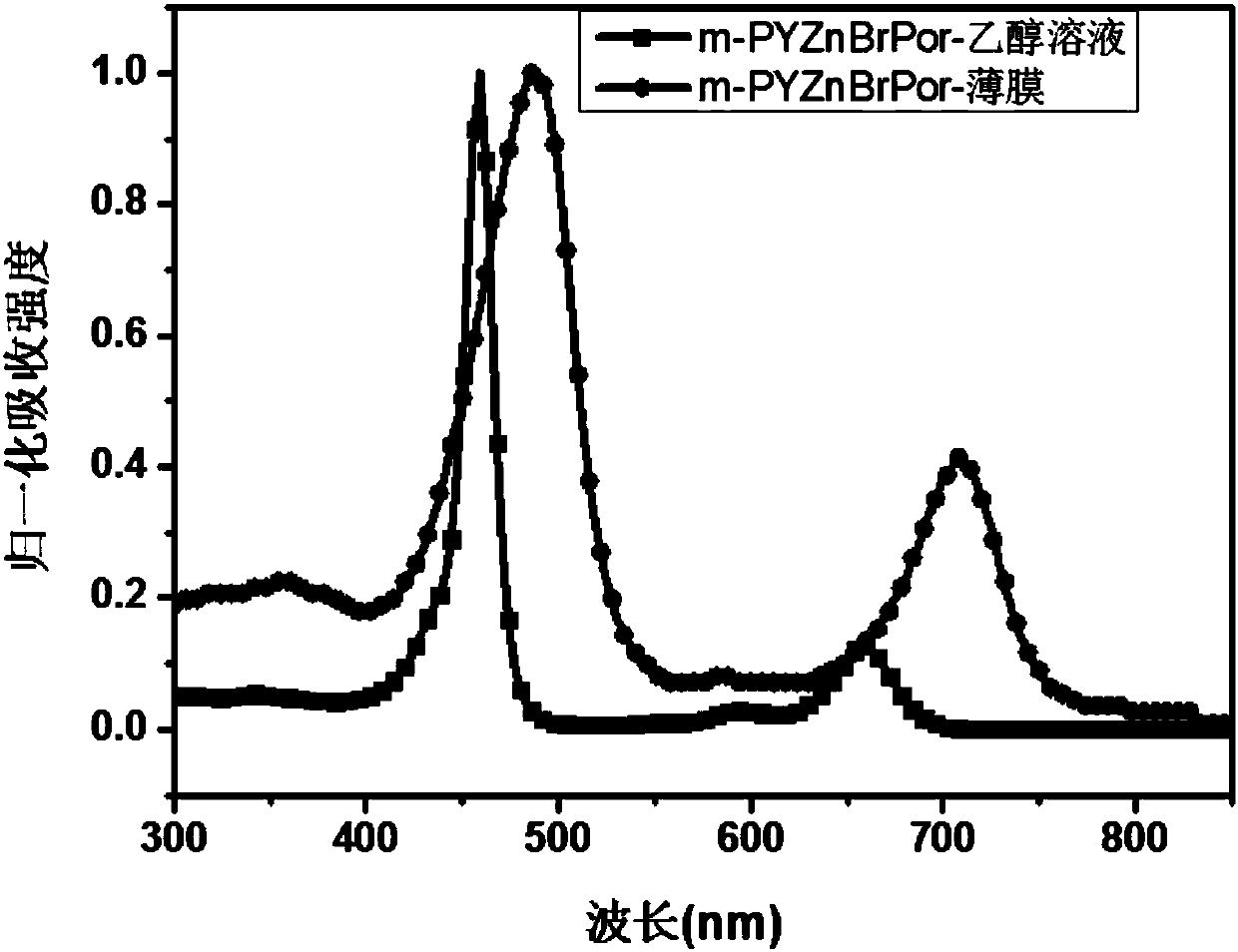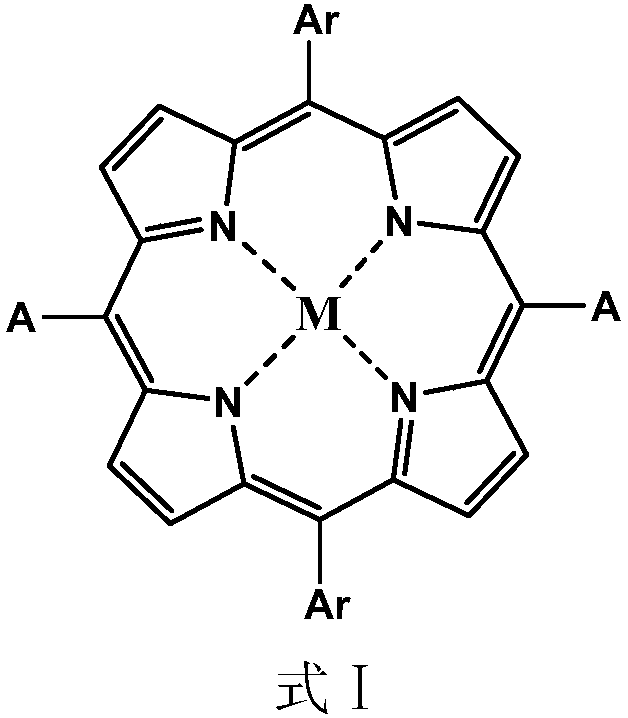Porphyrin small molecule perovskite cathode buffer layer material, preparation method and applications thereof
A cathode buffer layer and perovskite technology, applied in semiconductor/solid-state device manufacturing, photovoltaic power generation, electrical components, etc., can solve problems such as high production cost, low photoelectric conversion efficiency, and high energy consumption
- Summary
- Abstract
- Description
- Claims
- Application Information
AI Technical Summary
Problems solved by technology
Method used
Image
Examples
Embodiment 1
[0064] (1) Synthesis of 5,15-bis(5-(2-butyl)thiophene-2-octane)porphyrin
[0065] The reaction equation is as follows:
[0066]
[0067] In a 2L three-neck round-bottomed flask, add thiophenealdehyde (4.2g, 15.0mmol), bipyrromethane (2.19g, 15.0mmol) and 1.5L of dichloromethane, ventilate with nitrogen for 30 minutes, then add 0.18mL of trifluoro Acetic acid, stirred and reacted at room temperature for 12 hours, then added 5.55 g of 2,3-dichloro-5,6-dicyano-1,4-benzoquinone (DDQ), and continued to stir and reacted for 1 hour. After the reaction, use silica gel / (dichloromethane as the eluent) column chromatography, spin dry to obtain the crude product, and then recrystallize with chloroform / methanol to obtain a dark red solid (5,15-bis(5-(2 -butyl)thiophene-2-octane)porphyrin). 1 H NMR (500MHz, Chloroform-d) δ10.28(s, 2H), 9.44–9.28(m, 8H), 7.75(d, J=3.3Hz, 2H), 7.21(d, J=3.3Hz, 2H) ,3.10(d,J=6.7Hz,4H),1.93(h,J=6.3Hz,2H),1.65–1.34(m,32H),1.01(t,J=7.0Hz,6H),0.98–0.91( m,6...
Embodiment 2
[0091] Synthesis of 5,15-bis(ethyliodopyridinium quaternary ammonium-3-acetylene)-10,20-bis(5-(2-butyl)thiophene-2-octane)zinc porphyrin
[0092] The reaction equation is as follows:
[0093]
[0094] Reaction steps are the same as the step (6) of Example 1 ) of zinc porphyrin, the difference is that ethyl iodide replaces ethyl bromide for ionization, and the product is a blue solid (5,15-bis(ethyl iodopyridinium quaternary ammonium salt-3-acetylene)-10,20 - bis(5-(2-butyl)thiophene-2-octane)zinc porphyrin). 1 H NMR (500MHz, DMSO-d 6 )δ10.03 (s, 2H), 9.91 (d, J = 4.6Hz, 4H), 9.36 (dt, J = 8.2, 1.4Hz, 2H), 9.24 (dt, J = 6.1, 1.3Hz, 2H), 9.12(d, J=4.6Hz, 4H), 8.42(dd, J=8.1, 6.0Hz, 2H), 7.83(d, J=3.3Hz, 2H), 7.35(d, J=3.3Hz, 2H), 4.83(q,J=7.3Hz,4H),1.90(q,J=6.2Hz,2H),1.75(t,J=7.4Hz,4H),1.64–1.18(m,32H),0.98(t,J =7.1Hz,6H),0.93–0.84(m,6H).
Embodiment 3
[0095] The structure of embodiment 3 device
[0096] The ionized pyridine porphyrin-5,15-bis(ethyl bromide pyridinium quaternary ammonium salt-3-acetylene)-10,20-bis(5-(2-butyl)thiophene-2-octyl) prepared in Example 1 Alk) zinc porphyrin (m-PYBrZnPor) as a cathode buffer layer material for perovskite solar cells.
[0097] The structure of the perovskite solar cell device using m-PYBrZnPor as the cathode buffer layer is ITO / PTAA / perovskite layer (CH 3 NH 3 PB 3 ) / PCBM / m-PYBrZnPor / electrode Ag.
[0098] Preparation method of perovskite solar cell device using m-PYBrZnPor as cathode buffer layer:
[0099] (1) Preparation of PTAA layer: by solution method, a layer of PTAA (polytriethylamine) was spin-coated on the ITO transparent glass substrate as the anode interface. Spin coating for 40 seconds and anneal at 100°C for 10 minutes to obtain a 17nm thick PTAA layer;
[0100] (2) The structure of the photoactive layer, that is, the perovskite layer: on the PTAA layer, the PbI ...
PUM
| Property | Measurement | Unit |
|---|---|---|
| thickness | aaaaa | aaaaa |
Abstract
Description
Claims
Application Information
 Login to View More
Login to View More - R&D
- Intellectual Property
- Life Sciences
- Materials
- Tech Scout
- Unparalleled Data Quality
- Higher Quality Content
- 60% Fewer Hallucinations
Browse by: Latest US Patents, China's latest patents, Technical Efficacy Thesaurus, Application Domain, Technology Topic, Popular Technical Reports.
© 2025 PatSnap. All rights reserved.Legal|Privacy policy|Modern Slavery Act Transparency Statement|Sitemap|About US| Contact US: help@patsnap.com



